Understanding Sauna Temperature: Finding Your Sweet Spot
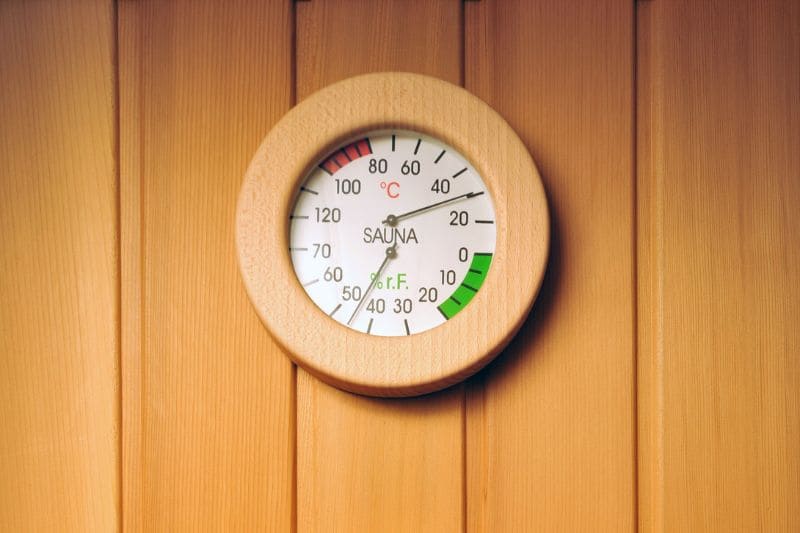
Did you know 99% of Finns love saunas, with temperatures up to 200°F? That’s hot enough to make you sweat buckets in seconds! But don’t worry, we’re not suggesting you turn yourself into a human lobster. Finding the right sauna temperature is crucial for both your comfort and health.
Sauna temperatures change with the type. Traditional (Finnish/dry) saunas go from 160-200°F with dry air. Infrared saunas are cooler, at 120-150°F. Steam rooms are warm and steamy, at 105-120°F, with lots of moisture.
But listen to your body and adjust as needed. The best sauna heat is a mix of temperature, humidity, and what feels right for you. Don’t go above 200°F to avoid getting sick from the heat. For a safe time, stick to 170-190°F and keep your session short, 10-20 minutes.
From traditional Finnish saunas to infrared options and steam rooms, we’ll help you find your sweet spot in the heat spectrum. Get ready to sweat it out – in the name of science and relaxation, of course!
Key Takeaways
- Sauna types and their temperature ranges:
- Traditional Finnish: 160-200°F (70-95°C)
- Infrared: 120-150°F (50-65°C)
- Steam rooms: 105-120°F (40-49°C)
- The Rule of 200: Temperature (°F) + Humidity (%) should equal 200 for optimal comfort
- Health benefits vary by temperature:
- Low (120-140°F): Improved sleep, weight loss, skin health
- Medium (160-180°F): Cardiovascular benefits, reduced mortality risk
- High (180-200°F): Intense detoxification, respiratory health
- Safety tips: Start with short sessions, hydrate well, listen to your body
- Customize your experience: Gradually increase temperature, adjust session duration
- Maintenance: Ensure proper ventilation, regular cleaning, and equipment checks
| Medical Disclaimer The information provided in this article is for educational purposes only and is not intended as medical advice. Always consult with a qualified healthcare professional before starting any new health regimen, including the use of saunas. The author and publisher of this content are not responsible for any adverse effects or consequences resulting from the use of any suggestions, preparations, or procedures described in this article. |
Table of Contents
Understanding Sauna Types and Their Temperature Ranges
Sauna types offer unique heat therapy experiences, each with distinct temperature ranges. Let’s explore the main sauna varieties and their typical heat settings. This will help you find your ideal sauna experience.
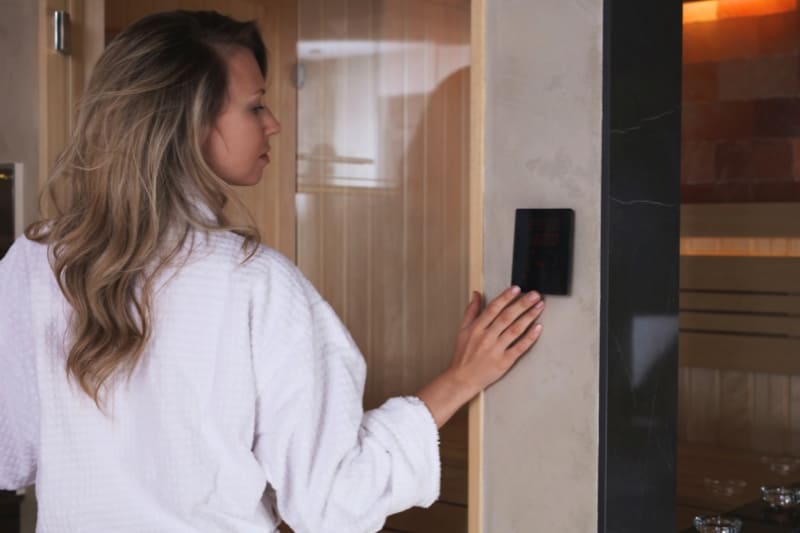
Traditional Finnish Saunas
Finnish saunas are the classic choice for heat lovers. These saunas get very hot, between 160-190°F. Some even hit up to 200°F, testing how much heat you can take. The North American Sauna Society suggests a safe range of 158-194°F (70-90°C).
Infrared Saunas
Infrared saunas heat your body with infrared panels. They run cooler, usually between 120-150°F. This lower heat lets you stay in longer, enjoying more heat therapy benefits.
Also Read: Infrared vs Traditional Sauna
Steam Rooms
Steam rooms, or Turkish baths, have a lot of moisture. They’re cooler than dry saunas, around 105-120°F. The moisture makes the heat feel stronger, giving a special sauna feel.
When picking a sauna, think about temperature and humidity. The World Health Organization warns against too much heat, which can cause illnesses. It’s key to choose the right temperature for your health and comfort.
The Science Behind Sauna Temperature
When you enter a sauna, your body starts to react in amazing ways. Your core temperature goes up, making your body do many things. Your heart beats faster, and your blood vessels get bigger, helping your blood flow better.
Sweating is a big part of the sauna experience. Your body sweats to cool down. This helps get rid of toxins and dirt from your skin. But sweating is just one way your body reacts to the heat.
Sauna heat works differently at different temperatures. At 70°C (158°F), it’s like a gentle stress. But at 100°C (212°F), it’s more intense, making your body work harder to stay cool.
Studies show that using a sauna often is good for your health. In Finland, people who used saunas a lot had lower risks of heart problems and brain diseases.1 This shows that saunas can be a key part of staying healthy.
Sweating does more than just clean your skin. It also makes you feel happy by releasing endorphins, which are natural chemicals in your body that reduce pain and boost mood.2 Plus, the heat can help your muscles grow and heal faster.
Knowing how saunas work can help you enjoy them more. Start with short times and lower heat, then slowly increase it. Always listen to your body and drink plenty of water to stay safe and happy in the sauna.

If you are new to saunas, I have got this in-depth article on “What are saunas” which will help you understand the basics of saunas.
Health Benefits of Different Sauna Temperatures
Sauna health effects change with the temperature. Each temperature level has its own benefits, meeting different needs. Let’s look at the advantages of sauna temperatures.
Low Temperature Benefits
Heat at 120 to 140°F in infrared saunas helps with sleep, weight loss, and clear skin. These temperatures are great for beginners or those with health issues. Using a sauna regularly at this level can also boost blood flow and ease joint pain.
Parasites like scabies mites die at 122°F (50°C) when sustained for 10+ minutes, as explored in our comprehensive article on sauna treatments for scabies infestations.
Also Read: How many calories do you burn in a sauna
Medium Temperature Benefits
Traditional dry saunas work at 160-180°F. This is a sweet spot for heart health. Studies show that 20-minute sessions at 174°F can cut down death risk by 40%.
High Temperature Benefits
Temperatures of 180-200°F in Finnish saunas help with deep detox. These sessions might lower heart disease risks, like high blood pressure and stroke. They could also help with breathing problems and ease osteoarthritis pain.
| Temperature Range | Sauna Type | Key Benefits |
|---|---|---|
| 120-140°F | Infrared | Improved sleep, weight loss, skin health |
| 160-180°F | Traditional Dry | Cardiovascular health, reduced mortality risk |
| 180-200°F | Finnish | Intense detoxification, respiratory health |
Try 4-7 sauna sessions a week, each about 20 minutes long for the best health benefits. Always pay attention to your body and change your sauna plan as needed.
Sauna Temperature: Finding Your Personal Comfort Zone
Finding the right sauna temperature is key for a great sauna experience. Your comfort level depends on what you like and your health.
Start by trying different temperatures. Begin with lower heat and slowly increase it. This way, you can adjust your sauna to what’s best for you.
Everyone is different when it comes to sauna comfort. Some like the high heat of Finnish saunas, while others prefer the softer warmth of infrared saunas. Listen to your body to make your sauna experience personal.
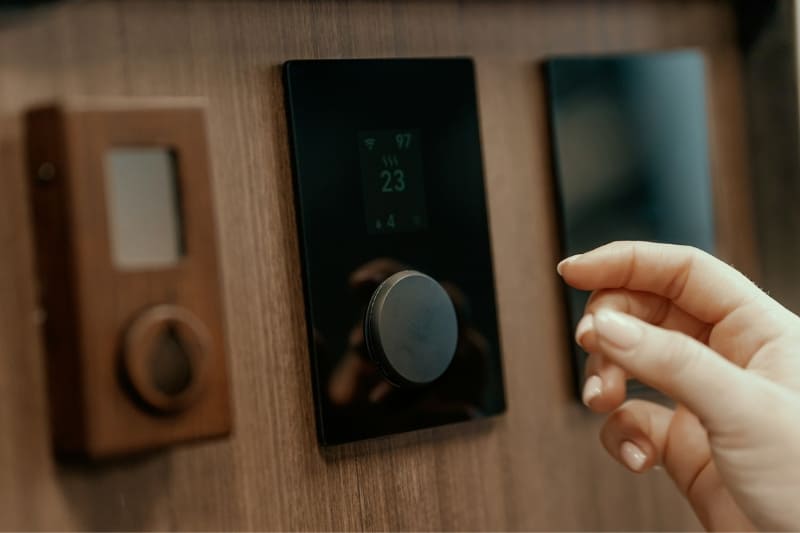
| Sauna Type | Temperature Range | Humidity Level |
|---|---|---|
| Traditional (Finnish/Dry) | 160-200°F (70-95°C) | 10-20% |
| Infrared | 120-150°F (50-65°C) | 40% |
| Steam (Wet/Turkish) | 105-120°F (40-49°C) | 100% |
Here are some tips to make your sauna better:
- Drink water before, during, and after your sauna.
- Take breaks to cool off and check how you feel.
- Use towels or headrests for extra comfort.
- Listen to your body and leave if it’s too much.
Find the perfect temperature for you to enjoy relaxation, stress relief, and better circulation from sauna use.
Related: How long does a sauna take to heat up
The Rule of 200: Balancing Temperature and Humidity
Sauna comfort comes from a fine balance of temperature and humidity. This balance is known as the Rule of 200. It means the sauna temperature in Fahrenheit plus the humidity percentage should add up to 200 for the best comfort.
Applying the Rule of 200
You can set your sauna to 160°F with 40% humidity or 170°F with 30% humidity. This combination makes a perfect place to enjoy sauna health benefits, including detox, better blood flow, and relaxation.
Adjusting Humidity Levels
To change sauna humidity, add water to heated rocks in traditional saunas. For wet saunas, keep the temperature between 150-175°F. On the other hand, dry saunas stay between 140-175°F for the best experience.
Optimal Comfort Settings
It’s important to find your perfect mix for comfort and benefits. Beginners may need time to get used to sauna heat. Try using fans or special controls to adjust the temperature. Start with sessions of 15-30 minutes and watch for any signs of discomfort.
Following the Rule of 200 helps make a safe and fun sauna. It makes your sauna time better and boosts health benefits.
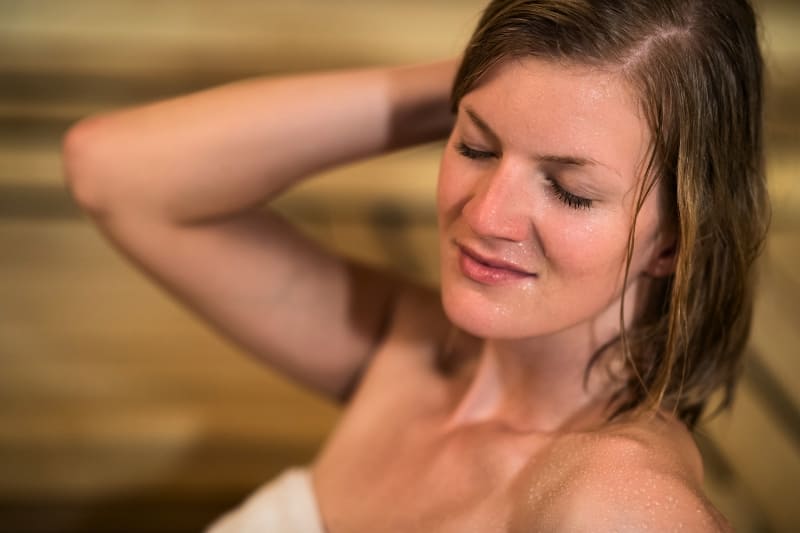
Safety Considerations for Sauna Temperature
Enjoying a sauna safely means paying attention to the temperature and how long you stay.
- Start with short sessions of 5-10 minutes at lower temperatures. Then, slowly increase to 20 minutes as you get used to it. This helps you find what feels right while keeping you safe.
- Keeping your sauna clean is important for safety. Clean benches with mild soap, sand them every year, and mop the floors every day. These steps keep the sauna clean and safe.
- Drink plenty of water before, during, and after your sauna.
- Get out fast if you feel dizzy or not right.
- Don’t drink alcohol, and talk to a doctor if you have health issues.
You’ll enjoy your sauna more and stay healthy by doing these things.
Remember, sauna sessions should not extend beyond 45–60 minutes to prevent dehydration or health issues. Always prioritize safety and comfort in your sauna routine.
Related: Sauna Safety Guide
Customizing Your Sauna Experience
Make your sauna sessions better by personalizing them. Adjust the temperature, time, and how often you go for the best results. Let’s see how to make your sauna fit your needs.
Temperature Progression Techniques
Begin with lower sauna temperatures and slowly increase them. Start with 120-140°F for beginners or infrared sauna fans. Then, try the middle heat of 150-160°F, and later, the high heat of 165-185°F. Always listen to your body and raise the temperature by 5-10°F at a time.
Related: How to make a sauna hotter
Duration and Frequency Recommendations
Start with sauna sessions of 5-10 minutes. As you get used to it, you can go up to 15-30 minutes. Choose how often you go to the sauna based on what you want and your health goals. For longer sessions, keep the temperature at 140°F to avoid getting too hot.
| Sauna Type | Temperature Range | Recommended Duration |
|---|---|---|
| Infrared | 120-149°F | 20-30 minutes |
| Traditional | 150-189°F | 10-20 minutes |
| Outdoor Hybrid | 140-189°F | 15-25 minutes |
Cooling Down Methods
Use cooling methods between sauna rounds for extra benefits. Try cold showers or plunge pools to enhance your sauna experience. This helps refresh you, boosts circulation, and aids in recovery.
Your perfect sauna routine is unique. Try different temperatures, times, and cooling methods to see what suits you best. Always drink plenty of water and enjoy finding your ideal sauna routine.

Sauna Temperature for Different Purposes
Sauna temperatures change based on what you want to achieve.
- For relaxing, aim for 150-170°F (65-76°C). This helps with stress and wellness without too much heat.
- Athletes do well in saunas at higher temperatures. Saunas at 170-190°F (76-88°C) help with endurance and recovery. These temperatures boost heart rate and blood flow, which is good for heart and circulation issues.
- For skin health, there are different sauna options. Infrared saunas at 120-150°F (50-65°C) are gentle yet effective for skin care. Steam rooms, with 100% humidity and 110-120°F (43-49°C), are great for skin.
| Sauna Type | Temperature Range | Primary Benefits |
|---|---|---|
| Traditional Finnish | 150-190°F (65-88°C) | Relaxation, Athletic Recovery |
| Infrared | 120-150°F (50-65°C) | Gentle Detox, Skin Health |
| Steam Room | 110-120°F (43-49°C) | Skin Care, Respiratory Health |
A study found sauna use cuts the risk of heart and metabolic diseases by half for those with high-stress jobs.
Start with lower temperatures and adjust as needed. Using a sauna right can bring many health benefits, improving your well-being.
Maintaining Ideal Sauna Temperature: Tips and Tricks
Keeping your sauna at the right temperature is key for a great experience. Let’s explore some practical tips for sauna maintenance and temperature control.
Proper Ventilation
Good sauna ventilation is crucial for heat consistency. Vents should be placed near the floor and ceiling to create airflow. This helps distribute heat evenly and keeps the air fresh. Remember, proper airflow impacts your comfort and the sauna’s efficiency.
Sauna Thermometer Placement
For accurate temperature readings, position your thermometer at head level. This gives you a true sense of the heat you’ll feel. Traditional saunas typically range between 150 to 195 degrees Fahrenheit, while infrared saunas usually operate from 120 to 150 degrees Fahrenheit.
Related: Best Sauna Thermometer
Regular Maintenance for Consistent Heat
Regular sauna maintenance ensures consistent heat output. Check your heater often and replace sauna rocks as needed. Clean your sauna regularly to prevent mold and maintain efficient heat distribution. For infrared saunas, ensure panels are working correctly and positioned for even heat spread.
| Sauna Type | Temperature Range | Maintenance Tips |
|---|---|---|
| Traditional | 160°F to 200°F | Replace rocks, clean heater |
| Infrared | 120°F to 150°F | Check panels, clean surfaces |
By following these tips, you’ll maintain ideal sauna temperatures and enjoy a consistent, comfortable experience.
Also read:
Why is my sauna not heating up
Best Rocks for Sauna
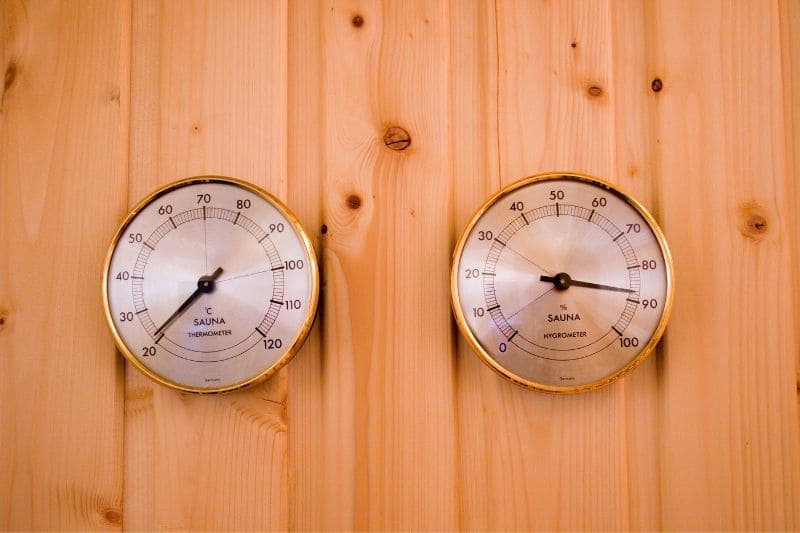
Conclusion
Finding the right sauna temperature is a journey. It’s about comfort, safety, and health benefits.
Whether you’re a heat-seeking missile aiming for that 200°F Finnish sauna experience or you prefer the gentler warmth of a 120°F infrared session, there’s a sauna temperature that’s just right for you.
The key is to listen to your body, start low, and work your way up. Don’t forget the Rule of 200 – it’s your ticket to balancing temperature and humidity for ultimate comfort.
So go ahead, test the waters (or should I say, test the steam?), and find your perfect sauna sweet spot.
FAQs About “Sauna Temperature”
What is the ideal sauna temperature range?
The ideal sauna temperature is 140-200°F (60-93°C). Most Americans prefer 150-175°F (65-79°C). Infrared saunas operate at lower temperatures, typically 100-150°F (38-65°C).
How do sauna types differ in their temperature ranges?
1. Traditional Finnish saunas: 160-190°F, low humidity
2. Infrared saunas: 120-150°F, uses infrared panels
3. Steam rooms (Turkish baths): 105-120°F, high humidity
How does sauna temperature affect the body?
Sauna heat increases body temperature, inducing sweating and elevated heart rate. This process can improve cardiovascular health, aid in detoxification, and enhance circulation.
What are the benefits of different sauna temperature ranges?
1. 100-130°F: Suitable for beginners, those with health concerns
2. 130-160°F: Improves circulation, promotes relaxation
3. 160-200°F: Enhances detoxification, provides cardiovascular benefits
How can I find my personal comfort zone in a sauna?
To find your personal comfort zone in a sauna, start at lower temperatures and gradually increase. Consider humidity levels, session duration, and your body’s response. Experiment with different temperatures while prioritizing safety and comfort.
What is the Rule of 200, and how can it help optimize sauna comfort?
The Rule of 200 states that temperature (°F) plus humidity (%) should equal 200 for optimal comfort. For example, 160°F with 40% humidity. Adjust humidity by adding water to sauna rocks.
What safety precautions should I take when using a sauna?
These are the safety precautions you should take when using a sauna:
1. Hydrate before, during, and after sessions
2. Limit sessions to 15-20 minutes initially
3. Exit if feeling unwell
4. Avoid alcohol before and during sauna use
5. Consult a doctor if you have health concerns
6. Ensure proper ventilation
How can I customize my sauna experience?
To customize your sauna experience:
1. Begin with lower temperatures, gradually increasing
2. Extend session duration as tolerance builds
3. Use cold showers or plunge pools between sessions
4. Adjust routine based on personal goals and comfort
What sauna temperatures are recommended for different purposes?
Here are the different purposes and their recommended sauna temperatures:
1. Relaxation: 150-170°F
2. Athletic performance/recovery: 170-190°F
3. Skin health: Steam rooms or lower temperature saunas
4. Detoxification: Higher temperatures for increased sweating
How can I maintain an ideal sauna temperature?
To maintain an ideal sauna temperature:
1. Ensure proper ventilation with floor and ceiling vents
2. Place thermometers at head level for accurate readings
3. Regularly check and maintain heaters
4. Replace sauna rocks as needed
5. Clean frequently to prevent mold and maintain even heat distribution
Resources
- https://www.medicalnewstoday.com/articles/313109 ↩︎
- https://www.ncbi.nlm.nih.gov/pmc/articles/PMC5941775/ ↩︎

“Become a Sauna Expert Overnight!”
Grab Your “FREE” Sauna E-book NOW!
Get your hands on the ultimate sauna manual. From history to DIY setups, our free guide has it all.

As a Chartered Accountant turned sauna enthusiast, I bring a unique blend of analytical skills and hands-on experience to the world of heat therapy. With over a decade dedicated to researching and testing sauna products and practices, I’ve developed a deep understanding of this field. A the founder of HomeInDepth.com, I provide reliable, easy-to-understand information on all aspects of saunas. My goal is to guide you through every step of your sauna journey, offering meticulously researched, unbiased advice to help you make informed decisions and create your perfect sauna experience. I’m always happy to hear from sauna lovers like you—feel free to leave questions or share your own tips in the comments below so we can learn together. Contact me on:







6 Comments